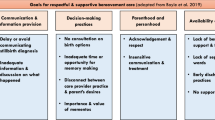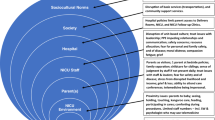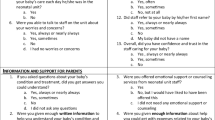Abstract
Objective:
Perinatal loss (stillbirth or early infant death) is often a sudden, unexpected event for families. We evaluated who communicates the loss to the parents and who is there for support at the delivery or death.
Study Design:
We conducted a mail survey of 900 bereaved and 500 live-birth mothers to assess emotional, physical and reproductive health outcomes.
Results:
We had a 44% response rate at 9 months after birth or loss from 377 bereaved mothers and 232 with surviving infants. Bereaved women were less likely to have hospital staff or family members present at delivery. African-American (versus Caucasian) mothers were half as likely to have first heard about their stillbirth from a physician or midwife.
Conclusion:
This is the first large study documenting who communicates perinatal death to families and who is present for support. Hospitals should be aware that many bereaved families may lack support at critical times.
This is a preview of subscription content, access via your institution
Access options
Subscribe to this journal
Receive 12 print issues and online access
$259.00 per year
only $21.58 per issue
Buy this article
- Purchase on Springer Link
- Instant access to full article PDF
Prices may be subject to local taxes which are calculated during checkout
Similar content being viewed by others
References
Kelley MC, Trinidad SB . Silent loss and the clinical encounter: parents' and physicians' experiences of stillbirth-a qualitative analysis. BMC Pregnancy Childbirth 2012; 12 (1): 137.
O'Connell O, Meaney S, O'Donoghue K . Caring for parents at the time of stillbirth: How can we do better? Women Birth 2016; 29: 345–349.
Pullen S, Golden MA, Cacciatore J . "I'll never forget those cold words as long as I live": parent perceptions of death notification for stillbirth. J Soc Work End Life Palliat Care 2012; 8 (4): 339–355.
Rosenblatt PC . Parent Grief: Narratives of Loss and Relationship. Brunner/Mazel: Philadelphia, PA, 2000.
Essex HN, Pickett KE . Mothers without companionship during childbirth: an analysis within the Millennium Cohort Study. Birth 2008; 35 (4): 266–276.
Christiansen DM, Elklit A, Olff M . Parents bereaved by infant death: PTSD symptoms up to 18 years after the loss. Gen Hosp Psychiatry 2013; 35 (6): 605–611.
Gold KJ, Boggs ME, Muzik M, Sen A . Anxiety disorders and obsessive compulsive disorder 9 months after perinatal loss. Gen Hosp Psychiatry 2014; 36 (6): 650–654.
Cacciatore J, Schnebly S, Froen JF . The effects of social support on maternal anxiety and depression after stillbirth. Health Soc Care Community 2009; 17 (2): 167–176.
Radestad I, Steineck G, Nordin C, Sjogren B . Psychological complications after stillbirth—influence of memories and immediate management: population based study. BMJ 312: 1505–1508.
Vance JC, Najman JM, Thearle MJ, Embelton G, Foster WJ, Boyle FM . Psychological changes in parents eight months after the loss of an infant from stillbirth, neonatal death, or sudden infant death syndrome—a longitudinal study. Pediatrics 1995; 96 (5 Pt 1): 933–938.
Gold KJ, Leon I, Boggs ME, Sen A . Depression and posttraumatic stress symptoms after perinatal loss in a population-based sample. J Womens Health 2016; 25 (3): 263–269.
Little RJA . Statistical Analysis with Missing Data,2nd edn.John Wiley & Sons: Hoboken, NJ, 2002.
Hamilton BE, Martin JA, Osterman MJ . Births: preliminary data for 2015. Nat Vital Stat Rep 2016; 65: 1–15.
Jabre P, Tazarourte K, Azoulay E, Borron SW, Belpomme V, Jacob L et al. Offering the opportunity for family to be present during cardiopulmonary resuscitation: 1-year assessment. Intensive Care Med 2014; 40 (7): 981–987.
De Stefano C, Normand D, Jabre P, Azoulay E, Kentish-Barnes N, Lapostolle F et al. Family presence during resuscitation: a qualitative analysis from a national multicenter randomized clinical trial. PLoS ONE 2016; 11 (6): e0156100.
Northam S, Knapp TR . The reliability and validity of birth certificates. J Obstet Gynecol Neonatal Nurs 2006; 35 (1): 3–12.
Mason LR, Nam Y, Kim Y . Validity of infant race/ethnicity from birth certificates in the context of U.S. demographic change. Health Serv Res 2014; 49 (1): 249–267.
Lydon-Rochelle MT, Cardenas V, Nelson JL, Tomashek KM, Mueller BA, Easterling TR . Validity of maternal and perinatal risk factors reported on fetal death certificates. Am J Public Health 2005; 95 (11): 1948–1951.
Cockerill R, Whitworth MK, Heazell AE . Do medical certificates of stillbirth provide accurate and useful information regarding the cause of death? Paediatr Perinat Epidemiol 2012; 26 (2): 117–123.
American Medical Association. Code of Medical Ethics: Chicago, IL, 1994.
American Institute of Ultrasound in Medicine. Official Statements: Interpretation of Ultrasound Examinations, approved 3/27/2010. 2010.
Alkazaleh F, Thomas M, Grebenyuk J, Glaude L, Savage D, Johannesen J et al. What women want: women's preferences of caregiver behavior when prenatal sonography findings are abnormal. Ultrasound Obstet Gynecol 2004; 23 (1): 56–62.
Leash RM . Death notification: practical guidelines for health care professionals. Crit Care Nurs Q 1996; 19 (1): 21–34.
Krahn GL, Hallum A, Kime C . Are there good ways to give 'bad news'? Pediatrics 1993; 91 (3): 578–582.
Acknowledgements
KJG was receiving funding through an NIMH K-23 at the time of this research.
Author information
Authors and Affiliations
Corresponding author
Ethics declarations
Competing interests
The authors declare no conflict of interest.
Rights and permissions
About this article
Cite this article
Gold, K., Treadwell, M., Mieras, M. et al. Who tells a mother her baby has died? Communication and staff presence during stillbirth delivery and early infant death. J Perinatol 37, 1330–1334 (2017). https://doi.org/10.1038/jp.2017.125
Received:
Revised:
Accepted:
Published:
Issue Date:
DOI: https://doi.org/10.1038/jp.2017.125



